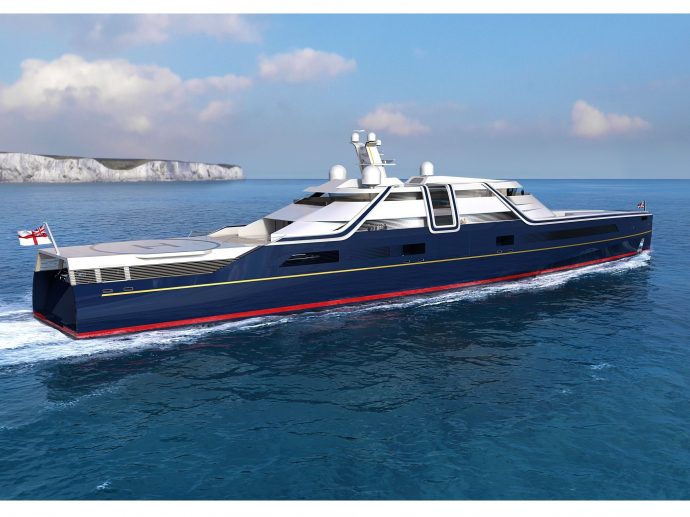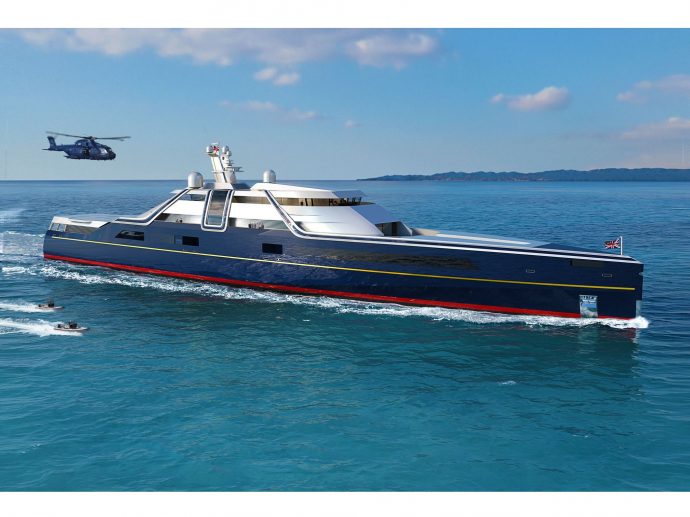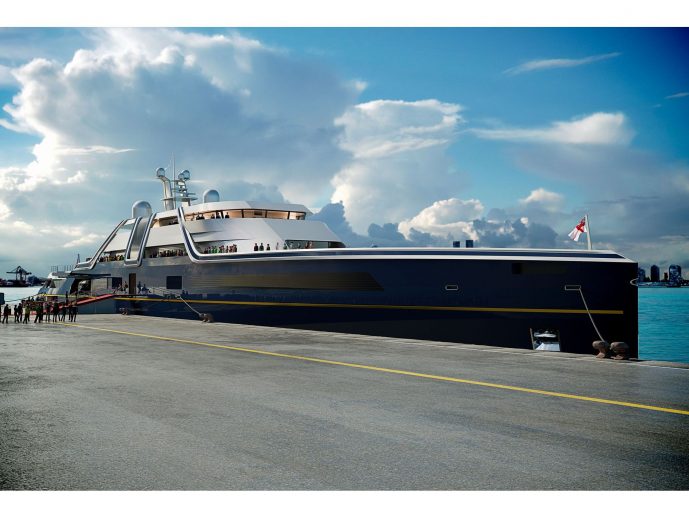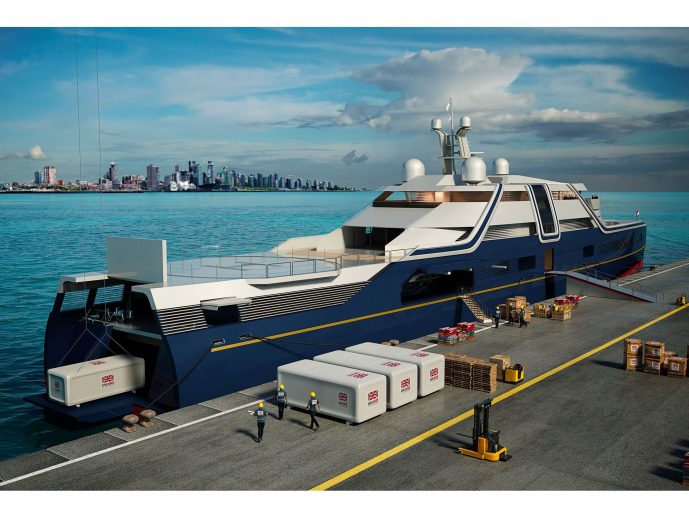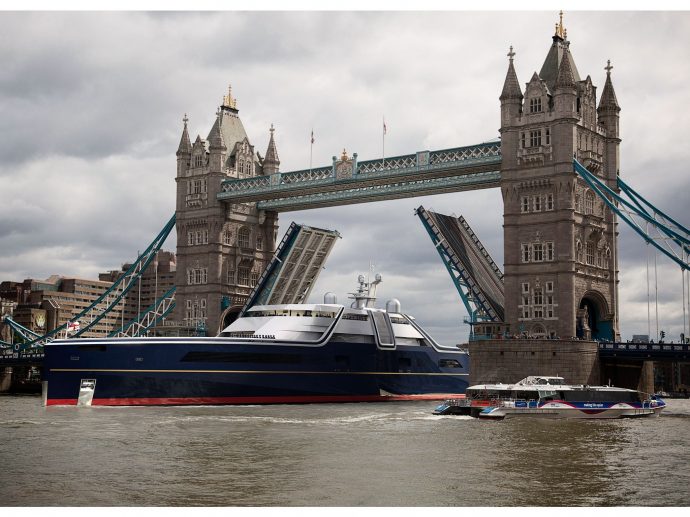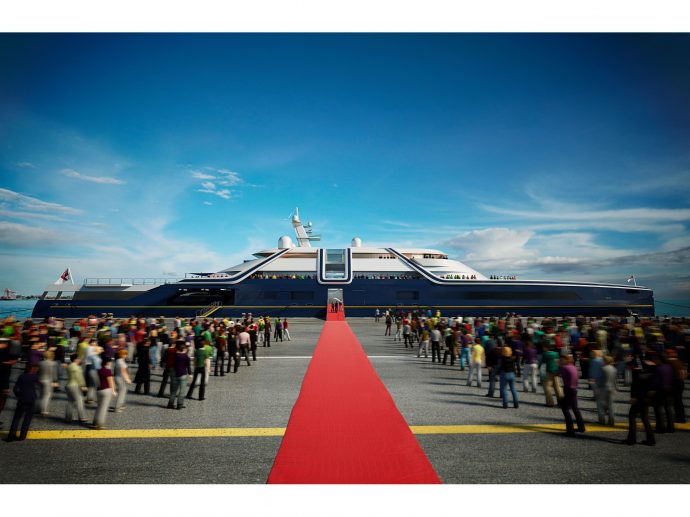Categories more
- Adventures (17)
- Arts / Collectables (15)
- Automotive (37)
- Aviation (11)
- Bath, Body, & Health (77)
- Children (6)
- Cigars / Spirits (32)
- Cuisine (16)
- Design/Architecture (23)
- Electronics (13)
- Entertainment (4)
- Event Planning (5)
- Fashion (45)
- Finance (9)
- Gifts / Misc (6)
- Home Decor (44)
- Jewelry (41)
- Pets (3)
- Philanthropy (1)
- Real Estate (15)
- Services (23)
- Sports / Golf (14)
- Vacation / Travel (60)
- Watches / Pens (14)
- Wines / Vines (24)
- Yachting / Boating (17)
Published
02/15/2023 by Vitruvius YachtsLondon-based studio reveals celebration of British society and technology in a vessel designed for the people but fit for a king.
When the British government invited designs for a new National Flagship – a replacement for the former Royal Yacht Britannia – it was an opportunity for Vitruvius Yachts and its collaborative team, called Team FestivAl, to combine their considerable knowledge and experience to create something extraordinary – a new flagship designed for the people but fit for a king.
With the government deciding to halt the project, the team – whose vessel was shortlisted as a finalist in the design competition – is showcasing their previously confidential proposal, highlighting not only the ingenuity of their design but also throwing a spotlight on the extraordinary depth and diversity of British industry and society, amply reflected in the design itself.
The design comes from Team FestivAl, a collaboration between London-based, award-winning yacht design studio Vitruvius Yachts, world-renowned architecture practice Zaha Hadid Architects, and aluminium ship and yacht specialists Ocea. Key features include a focus on sustainable power and propulsion, a highly efficient hull design to minimise fuel consumption and maximise opportunities for emerging green technologies to create a zero-carbon vessel, an interior based on recycled and recyclable materials, and a flexible deck and interior design that can switch between exhibition showcase or floating embassy with ease, suitable for everyone from VVIPs to schoolchildren and the disabled.
Spearheaded by Vitrivius Yachts’ Philippe Briand – one of the world’s leading yacht designers and a naval architect for both sail and motor yachts – Team FestivAl’s National Flagship project draws on several cultural and societal cues, from innovation and sustainability to accessibility and inclusion, to represent the very best of British in design, manufacturing, craftsmanship and diversity. Indeed, in developing the design, the essence of Britishness takes centre stage through a Union flag ribbon motif in the side and plan view elevations, while reflecting the multicultural society that defines the UK today.
“To design a vessel – a flagship – that will become a benchmark in sustainability as well as demonstrating British excellence and heritage for current and future generations, while also being a symbol of inclusion and diversity, was an enormous challenge that kept me awake at night,” says Philippe Briand. “The nature and intensity of the project kept me focused but also filled me with pride, not just in the design process itself but for what the flagship stands for.”
A sustainability and technology showcase
The technical elements of Team FestivAl’s national flagship project centre on sound naval architecture and clever superstructure design. The result is a 125-metre vessel that is both highly efficient in the water – with 30 percent less hydrodynamic drag than a conventional steel ship – and also in the air, with a drag coefficient of just 0.28 which is less than most cars.
The design would be built in recycled aluminium (the ‘Al’ in ‘Team FestivAl’), which is lighter than steel and therefore reduces the power required for propulsion, which in turn reduces emissions. Indeed, Team FestivAl conducted a study with the non-profit Water Revolution Foundation in conjunction with the University of Bologna which found that the hull and superstructure design, over a lifecycle of 30 years, would emit 30 percent less greenhouse gases than a conventional design.
The National Flagship design goes further, however, with an energy-agnostic propulsion system based on highly efficient pod drives, which can also enable geostationary position-keeping without damaging sensitive seabeds with an anchor. Power for the pod drives would come from a large battery bank that could be charged via shore power or onboard generators, initially using renewable diesel/biofuel but allowing for alternative energy sources now and in the future including green hydrogen fuel cells and onboard-harvested solar and wind energy.
The best of British design and craftsmanship
Both the exterior and interior designs have been created to portray national identity and showcase the very best of British design and craftsmanship. The sleek exterior profile includes a distinctive central slice through the superstructure that takes the form of a hoop of glass, flooding the interior with light and providing a key design element that, combined with a distinct LED-lit style line in the profile, hints at the ribbon pattern in the Union flag. This is reinforced in the design when viewed from above.
At night, the LED-tile ribbon and lighting scheme developed by Jason Bruges Studio turns the vessel into a lighting sculpture that projects the Union flag, reflected in the water. The lighting scheme also allows for messages to be displayed, and for lighting to be matched to a given theme or location.
The interior has been conceived to give each area its own identity while creating a cohesive, holistic overarching theme that represents British creativity, craftsmanship, decoration, furniture and artefacts. A simple graphic representation of the vessel’s side profile resembling the Union flag ribbon is a design motif that is repeated throughout the interior.
The main arrival point for guests and visitors is the spectacular central atrium, where wall-to-wall displays will show presentations adaptable to the role of the vessel at the time, and packages of content proudly reflecting the UK’s maritime industry, green technology and culture. The multi-sensorial experience, replicated throughout the ship, includes sign language and audio descriptions.
Flexibility and inclusion
Central to the vessel’s design is accessibility for all across all decks and areas. The wraparound glass of the atrium provides not only a great sense of light and space but also delivers plenty of natural light for the visually impaired. Access routes throughout the vessel have been considered with people of all ages and all levels of ability or disability in mind.
The interior spaces themselves have been developed around a need for flexibility of use and purpose, from national showcase and exhibition space to state dinners and private receptions. These include a large aft formal dining room that can be configured in multiple ways; a greeting/bar area with breakout rooms, and moveable partitions that allow for quick switching between operational modes; and a modular mission bay in the aft end of the vessel that can be used for trade show demonstrations, storage of additional equipment or humanitarian supplies and modular medical facilities, a modular science lab or extra accommodation or office space.
“The flagship collaboration was an incredible opportunity to act as an architect realising the design of a project that was hugely complex, because it aims to represent not the tastes of one person but the essence of an entire nation,” Briand enthuses. “That is actually way more difficult than designing for even the most demanding individual!”
Indeed, Team FestivAl’s National Flagship is more than just a design exercise – it is a celebration of the UK as a vibrant and inclusive multicultural society, as a hotbed of design, engineering and manufacturing, and as a nation with a rich seafaring heritage and a world-leading future as a developer of sustainable technologies.














